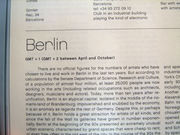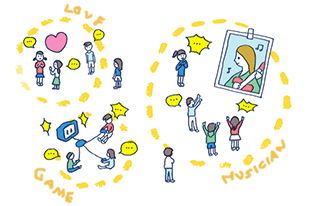“未國”MI-KUNI公演 [GENBAKU Onomatopoeia] in Berlin 出演者オーディションのお知らせ
・オーディション日時 (ワークショップ形式):3月14-20日 13-17時
(うち2日間以上参加願います)
(上記日程が無理な方は、相談させて頂きたいと存じます)
・本番日:2011年5月4日(水)(前日5/3は、劇場リハーサル室での通しとなります)
・劇場:Ballhaus Naunynstrasse “Diyalog Theater Fest”
・募集条件:日本人男女(男性2名、女性4名程度)
5/4本番、5/3の劇場リハーサルに参加可能であること
4月より行われるベルリンでのリハーサルに参加出来る事
(日数は25日間程度、4月5月平日・日曜)
*今後行われる未國の舞台に永続的に参加して頂ける方、歓迎致します。
・パフォーマンス内容:
アクティング、ダンス、ボイス、あらゆる身体表現、打楽器奏者
・出演料:
交通費として50€、報酬については要相談でお願いします。
・未國とは:
私たちは昨年2010年末より東京からベルリンに拠点を移し活動しております。
渡独以降、定期的にクロイツベルグのカフェ[Roderich]でパフォーマンスを
行いながら、ドイツ国内、及びヨーロッパ各地での公演を計画しています。
5月は今回の作品「GENBAKU Onomatopoeia」でBallhaus、6月は別の作品
「JomonKomachi」でTheaterHausMitte、Roderichに出演が決定しています。
また、未國では日本的な物語/音楽(例えば「能」や「民話/俗謡」の根底に流れる
情緒的なもの)を大事にしています。
最下記、未國の英文サマリーです。目を通して頂ければ幸いです。
・作品名:
「GENBAKU Onomatopoeia」
・内容:
この作品は、広島の惨劇の刹那にあった“戀の物語”です。
惨劇から60年経ってもその戀を忘れらず苦悩するある老作曲家が死の間際に多くの
想い(亡者)と出会いながら最後の作曲を果たしその生涯を成就する話です。ベースと なるのは、広島で命を落とした“広島一女”の女学生と疎開作業をする“少年兵士”の儚い 戀、それに源氏物語の“夕顔と源氏”重ねあわせたものです。要約するとすれば“輪廻と 罪業”“悲劇と戀”が折り重なった物語です。
"At the moment of atrocity at Hiroshima, a man and a woman made realized that their love was in everlasting moment."
A composer who lives in this world finds the essential purpose of life facing the sin with music.
This is a performance based on the Japanese classic work "Tale of Genji", and represents the form of timeless love and the ring of destiny.
Atomic bombings in Nagasaki and Hiroshima are a largest tragedy in history. People who witnessed the threat of bombing for the first time voiced “Pika-Don”, which is an onomatopoetic word in Japanese expressing ‘flashing and blasting’ of atomic bombing. The onomatopoeia coming from the flashing and blasting and stories brought by it are resonating with our souls beyond all ideologies and ideas. MI-KUNI found “primitive vitality and energy” and its “possibility” in the onomatopoeia in the same way as Japanese ancient performing arts which we have tackled and worked on, or more than that. In the abysmal tragedy, pure and innocent spirits are dancing and singing in the extreme depth of death. This production, “GENBAKU Onomatopoeia” which we believe can be a classic in the future goes beyond all things and lays out fascinating performance on the stage.
下記eメールにてお問合せ下さい。
メールに
名前/性別/年齢/住所/電話番号/専門分野
を添えて下さい。
問合せ先:未國 制作:前田新奈
niina@mi-kuni.com
017674115695
未國HP: www.mi-kuni.com
________________________________________________________
[About MI-KUNI: Theater and Music]
Body, voices, rhythm and a sphere of singularity .
Mi-kuni, it is a group evoking a primitive feeling in the modern world.
“‘Avant-garde’ lies deep in nature/culture and history of Japan.
What I want to show through performances by MI-KUNI is that innovative stage
arts come up from regional traditions and native customs of this country.”
Maegawa Jujiro
All performing arts of Japan are “Matsuri” (Japanese festival).
Zokuyo (folk ballads), Kagura (Shinto ceremonial dances), Noh (traditional masked dancedrama),
and Gagaku (ancient court dance and music) are among Japanese traditional arts coming down to the present time. In such field, any and all people were integrated and mingled without any boundaries of classes, professions or religions. They found the joy of living at the moment of “Matsuri” .
Performers belonging to various fields got together in Mi-kuni and aim to produce stage arts evoking a primitive feeling in this modern world by using “Matsuri” as the source of creation.
In Tokyo 2002, we Mi-kuni was organized by several creators who are dancers, musicians,visual artists along with sympathies with Jujiro's work. More than a dozen works which were created through the past decade are amazingly various. For instance, in a work which based on
Noh classic, we performed it with movie on the imitated stage as if it's like a Kabuki theater,and in a work based on " “Matsuri” , Japanese ancient ritual , we performed it as a live art which include both instrumental and vocal music. At these expermental approaches, we refined it into simple expression which consisted of voice, body and rhythm. So to speak, true to Jujiro's word, we Mi-kuni are continue to pursue wild and atypical another space not a smart and typical stage, with repeated approaches which stimulate our sense of primitive.
[Future Vision]
Since 2006, in the series of “Hebi Onna”, a contemporary work using
Japanese Noh drama as its theme, we have sincerely challenged to
produce stage arts by repeatedly examining, deconstructing and
reconstructing Japanese culture from various perspectives with
“discovery and presentation of cultural resources” as the keyword.
We will further enhance the degree of completion of “MAROUDO”, a work first staged in 2008, which is based on a curious work by Shinobu Origuchi, “Shisha no Sho (book by the dead)” and traditional Noh music, “Taimadera (Taima Temple)”, by pursuing every possibility of expression. And we are now working for completion of a new production, “GENBAKU Onomatopoeia ” to be presented in 2009, featuring spark of lights of the atomic bomb.
・オーディション日時 (ワークショップ形式):3月14-20日 13-17時
(うち2日間以上参加願います)
(上記日程が無理な方は、相談させて頂きたいと存じます)
・本番日:2011年5月4日(水)(前日5/3は、劇場リハーサル室での通しとなります)
・劇場:Ballhaus Naunynstrasse “Diyalog Theater Fest”
・募集条件:日本人男女(男性2名、女性4名程度)
5/4本番、5/3の劇場リハーサルに参加可能であること
4月より行われるベルリンでのリハーサルに参加出来る事
(日数は25日間程度、4月5月平日・日曜)
*今後行われる未國の舞台に永続的に参加して頂ける方、歓迎致します。
・パフォーマンス内容:
アクティング、ダンス、ボイス、あらゆる身体表現、打楽器奏者
・出演料:
交通費として50€、報酬については要相談でお願いします。
・未國とは:
私たちは昨年2010年末より東京からベルリンに拠点を移し活動しております。
渡独以降、定期的にクロイツベルグのカフェ[Roderich]でパフォーマンスを
行いながら、ドイツ国内、及びヨーロッパ各地での公演を計画しています。
5月は今回の作品「GENBAKU Onomatopoeia」でBallhaus、6月は別の作品
「JomonKomachi」でTheaterHausMitte、Roderichに出演が決定しています。
また、未國では日本的な物語/音楽(例えば「能」や「民話/俗謡」の根底に流れる
情緒的なもの)を大事にしています。
最下記、未國の英文サマリーです。目を通して頂ければ幸いです。
・作品名:
「GENBAKU Onomatopoeia」
・内容:
この作品は、広島の惨劇の刹那にあった“戀の物語”です。
惨劇から60年経ってもその戀を忘れらず苦悩するある老作曲家が死の間際に多くの
想い(亡者)と出会いながら最後の作曲を果たしその生涯を成就する話です。ベースと なるのは、広島で命を落とした“広島一女”の女学生と疎開作業をする“少年兵士”の儚い 戀、それに源氏物語の“夕顔と源氏”重ねあわせたものです。要約するとすれば“輪廻と 罪業”“悲劇と戀”が折り重なった物語です。
"At the moment of atrocity at Hiroshima, a man and a woman made realized that their love was in everlasting moment."
A composer who lives in this world finds the essential purpose of life facing the sin with music.
This is a performance based on the Japanese classic work "Tale of Genji", and represents the form of timeless love and the ring of destiny.
Atomic bombings in Nagasaki and Hiroshima are a largest tragedy in history. People who witnessed the threat of bombing for the first time voiced “Pika-Don”, which is an onomatopoetic word in Japanese expressing ‘flashing and blasting’ of atomic bombing. The onomatopoeia coming from the flashing and blasting and stories brought by it are resonating with our souls beyond all ideologies and ideas. MI-KUNI found “primitive vitality and energy” and its “possibility” in the onomatopoeia in the same way as Japanese ancient performing arts which we have tackled and worked on, or more than that. In the abysmal tragedy, pure and innocent spirits are dancing and singing in the extreme depth of death. This production, “GENBAKU Onomatopoeia” which we believe can be a classic in the future goes beyond all things and lays out fascinating performance on the stage.
下記eメールにてお問合せ下さい。
メールに
名前/性別/年齢/住所/電話番号/専門分野
を添えて下さい。
問合せ先:未國 制作:前田新奈
niina@mi-kuni.com
017674115695
未國HP: www.mi-kuni.com
________________________________________________________
[About MI-KUNI: Theater and Music]
Body, voices, rhythm and a sphere of singularity .
Mi-kuni, it is a group evoking a primitive feeling in the modern world.
“‘Avant-garde’ lies deep in nature/culture and history of Japan.
What I want to show through performances by MI-KUNI is that innovative stage
arts come up from regional traditions and native customs of this country.”
Maegawa Jujiro
All performing arts of Japan are “Matsuri” (Japanese festival).
Zokuyo (folk ballads), Kagura (Shinto ceremonial dances), Noh (traditional masked dancedrama),
and Gagaku (ancient court dance and music) are among Japanese traditional arts coming down to the present time. In such field, any and all people were integrated and mingled without any boundaries of classes, professions or religions. They found the joy of living at the moment of “Matsuri” .
Performers belonging to various fields got together in Mi-kuni and aim to produce stage arts evoking a primitive feeling in this modern world by using “Matsuri” as the source of creation.
In Tokyo 2002, we Mi-kuni was organized by several creators who are dancers, musicians,visual artists along with sympathies with Jujiro's work. More than a dozen works which were created through the past decade are amazingly various. For instance, in a work which based on
Noh classic, we performed it with movie on the imitated stage as if it's like a Kabuki theater,and in a work based on " “Matsuri” , Japanese ancient ritual , we performed it as a live art which include both instrumental and vocal music. At these expermental approaches, we refined it into simple expression which consisted of voice, body and rhythm. So to speak, true to Jujiro's word, we Mi-kuni are continue to pursue wild and atypical another space not a smart and typical stage, with repeated approaches which stimulate our sense of primitive.
[Future Vision]
Since 2006, in the series of “Hebi Onna”, a contemporary work using
Japanese Noh drama as its theme, we have sincerely challenged to
produce stage arts by repeatedly examining, deconstructing and
reconstructing Japanese culture from various perspectives with
“discovery and presentation of cultural resources” as the keyword.
We will further enhance the degree of completion of “MAROUDO”, a work first staged in 2008, which is based on a curious work by Shinobu Origuchi, “Shisha no Sho (book by the dead)” and traditional Noh music, “Taimadera (Taima Temple)”, by pursuing every possibility of expression. And we are now working for completion of a new production, “GENBAKU Onomatopoeia ” to be presented in 2009, featuring spark of lights of the atomic bomb.
|
|
|
|
|
|
|
|
ベルリンのアートシーン 更新情報
-
最新のアンケート
-
まだ何もありません
-























